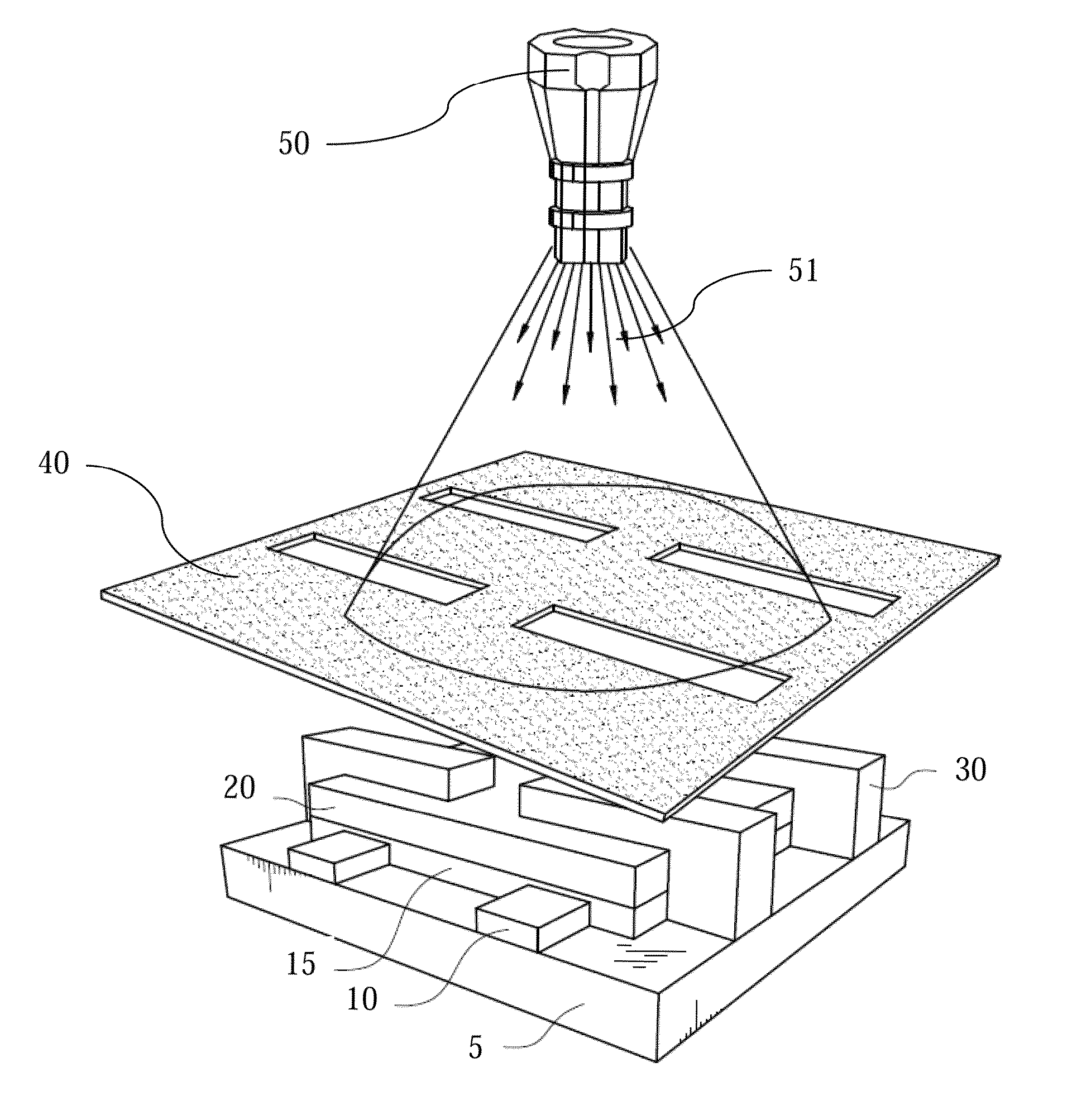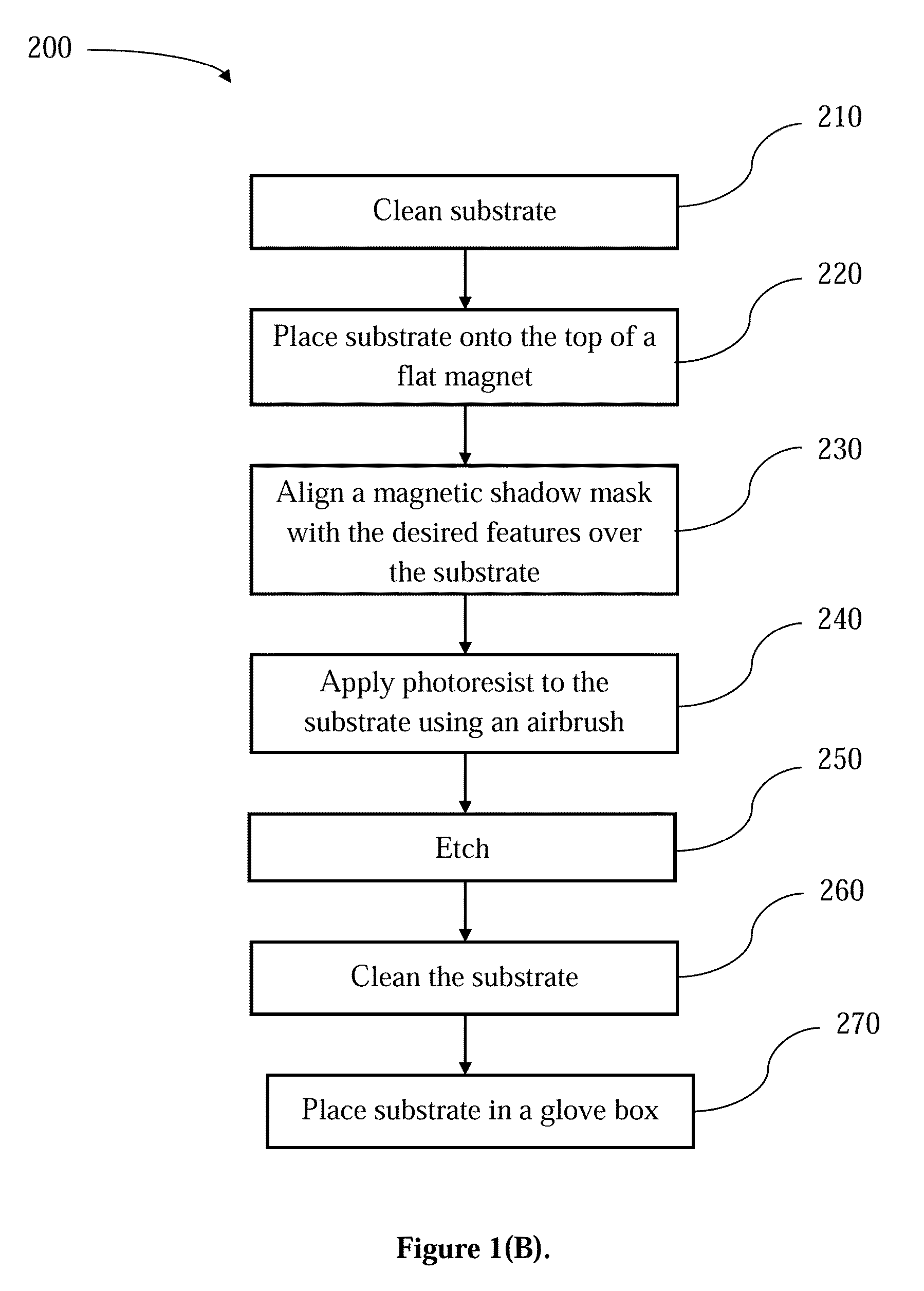Transparent contacts organic solar panel by spray
a solar panel and transparent technology, applied in the field of organic solar cells, can solve the problems posting difficulties in large-scale manufacturing, and achieve the effect of limiting the transparency of solar cells
- Summary
- Abstract
- Description
- Claims
- Application Information
AI Technical Summary
Benefits of technology
Problems solved by technology
Method used
Image
Examples
example 1
[0056]An indium tin oxide (ITO) with and Corning® low alkaline earth boro-aluminosilicate glass substratehaving a nominal sheet resistance of 4-10 Ω / square (Delta Technology, Inc. Phoenix, Ariz.) was pre-cut 4″×4″, and patterned using a positive photo resist, Shipley 1813, spray coated using an airbrush having a fine tip. The substrate was placed on top of a flat magnet and a magnetic shadow mask with desired features was aligned over the substrate. Shipley 1813 was spray coated using nitrogen (N2) as the carrier gas, set to 3 on a hotplate set to 130° C., depending on solution volume. The structure was removed from etchant and cleaned using sonication in trichloroethylene (TCE), followed by a sonication cleaning in acetone followed by isopropanol at 50° C. for 20 minutes for each cleaning. The structure was further cleaned using UV-ozone for thirty minutes. The patterned substrate was then placed in a glove box.
[0057]An interstitial layer was formed on top of the patterned ITO laye...
example 2
[0061]ITO glass substrates with a nominal sheet resistance of 4-10 Ω / square and Corning® low alkaline earth boro-aluminosilicate glass (Delta Technology, Inc., Tallahassee, Fla.), hereinafter substrate 5, were pre-cut 4″×4″ and cathode 10, also known as cathode layer, patterned as described in Example 1. As seen in FIG. 2(a), interstitial layer 15 was spray coated on top of patterned cathode layer 10 using a solution of 0.2% wt. Cs2CO3 (2 mg / mL; Sigma-Aldrich Co. LLC, St. Louis, Mo.) in 2-ethoxyethanol was prepared, as described above. Active layer 20 was prepared using a solution poly(3-hexylthiophene (Rieke Metals, Inc., Lincoln, Nebr.) and 6,6-phenyl C61 butyric acid methyl ester (Nano-C, Inc., Westwood, Mass.) at a weight ratio of 1:1 in dichlorobenzene and spray coated onto the Cs2CO3 coated substrate using an airbrush with N2 set to 30 psi, as described in Example 1.
[0062]Anode 30 was spray coated using aqueous, filtered solution of PEDOT:PSS mixed with 5 vol. % of dimethylsul...
example 3
[0066]Inverted organic photovoltaic cell 1 was created using the method described in Example 1, using substrate 5, a pre-cut 4″×4″ ITO glass substrates with a nominal sheet resistance of 4-10 Ω / square and Corning® low alkaline earth boro-aluminosilicate glass (Delta Technology, Inc., Tallahassee, Fla.). Cathode 10, comprised of ITO in the present example, was sprayed onto substrate 5 forming a ‘¦¦’ pattern extending from a first set of edges of substrate 5, as seen in FIG. 3. Interstitial layer 15 was sprayed onto cathode 10, except for the outermost edges, as seen in FIG. 4, and permits ITO to be used as a cathode, as discussed in Example 1. Active layer 20 was sprayed directly on top of interfacial buffer layer 15, seen in FIG. 5, and was prepared using poly(3-hexylthiophene) and 6,6-phenyl C61 butyric acid methyl ester. The active layer were chosen to provide a gradient for charges crossing the interface, approximating a conventional p-n junction with organic semiconductors, ther...
PUM
| Property | Measurement | Unit |
|---|---|---|
| thick | aaaaa | aaaaa |
| thick | aaaaa | aaaaa |
| thick | aaaaa | aaaaa |
Abstract
Description
Claims
Application Information
 Login to View More
Login to View More - R&D
- Intellectual Property
- Life Sciences
- Materials
- Tech Scout
- Unparalleled Data Quality
- Higher Quality Content
- 60% Fewer Hallucinations
Browse by: Latest US Patents, China's latest patents, Technical Efficacy Thesaurus, Application Domain, Technology Topic, Popular Technical Reports.
© 2025 PatSnap. All rights reserved.Legal|Privacy policy|Modern Slavery Act Transparency Statement|Sitemap|About US| Contact US: help@patsnap.com



